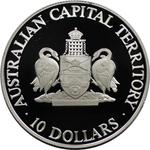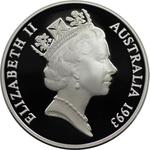Ten Dollars Silver 1993 Australian Capital Territory, Coin from Australia - detailed information
| ||||||
The regular circulating coinage of Australia includes coins from 5 cents up to two dollars. Apart from those, the Royal Australian Mint also issues non-circulating coins for collectors, some of which are made of silver and denominated as $10 (ten dollars). These are not bullion, since they are sold at prices much higher than the intrinsic value of the precious metal they contain. This coin is the last issue in a series which represents the individual States and Territories of the Commonwealth of Australia, and features the Coat of Arms of the Australian Capital Territory. The Australian Capital Territory (ACT), known as the Federal Capital Territory (FCT) until 1938, is a federal territory of Australia. Canberra, the capital city of Australia, is located in this territory. It is located in southeastern Australian mainland as an enclave completely within the state of New South Wales. Founded after Federation as the seat of government for the new nation, the territory hosts the headquarters of all important institutions of the Australian Government. | ||||||
| ||||||
| ||||||
| ||||||
| ||||||
| ||||||
| ||||||
 |
| Royal Mint |
Coins in the Australian States and Territories Silver Ten Dollars series:
- $10 Silver, Victoria, 1985
- $10 Silver, South Australia, 1986
- $10 Silver, New South Wales, 1987
- $10 Silver, Queensland, 1989
- $10 Silver, Western Australia, 1990
- $10 Silver, Tasmania, 1991
- $10 Silver, Northern Territory, 1992
- $10 Silver, Australian Capital Territory, 1993
 |
| Buy American Gold Buffalo Coins |
| Country | Australia |
|---|---|
| Currency | Australian Dollar |
| Coin Type | Ten Dollars, Silver |
| Issued | 1993 |
| Monarch | Queen Elizabeth II |
| Effigy | Queen Elizabeth II - Third Portrait, by Raphael Maklouf |
| Face Value | 10 (x Dollar) |
| Total Mintage | 40,471 |
| Current | Yes |
| Material | 0.925 Silver |
| Designer | Wojciech Pietranik |
| Technology | Milled (machine-made) |
| Shape | Round |
| Orientation | Medal Alignment (Axis 0) |
| Size | 34.0000 mm |
| Thickness | 2.550 mm |
| Mass | 20.0000 g |
| OCC ID | YRVP-OVRC-MVZK-ODQG |
 |
| Handbook of United States Coins 2025 |
| Image | Details |
|---|---|

|
1993 $10 Australian Capital Territory Silver Uncirculated Coin
Copyright: Downies Source |

|
1993 $10 Australian Capital Territory Silver Uncirculated Coin
Copyright: Downies Source |

|
Australian Capital Territory. 10 Dollars 1992 Proof
Copyright: Numisbids Source |

|
Australian Capital Territory. 10 Dollars 1992 Proof
Copyright: Numisbids Source |
| Source | Reference ID |
|---|---|
| Krause, Standard Catalog of World Coins | Australia KM# 210 |


 Search for Australia: Ten Dollars Silver 1993 Australian Capital Territory on eBay
Search for Australia: Ten Dollars Silver 1993 Australian Capital Territory on eBay